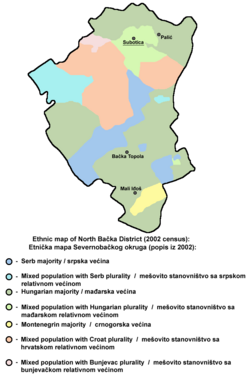

The North Bačka District (Serbian: Севернобачки округ, romanized: Severnobački okrug, pronounced [sêʋeːrnobâːtʃkiː ôkruːɡ]; Hungarian: Észak-bácskai körzet) is one of seven administrative districts of the autonomous province of Vojvodina, Serbia. It lies in the Bačka geographical region. According to the 2022 census results, it has a population of 160,163 inhabitants. The administrative center of the district is the city of Subotica.
In the 9th century, the area was ruled by the Bulgarian-Slavic duke Salan. From the 11th to the 16th century, during the administration of the medieval Kingdom of Hungary, the area was divided between the Bodrogiensis County, Bacsensis County, Csongradiensis County, and Cumania region. From 1526 to 1527, the area was ruled by the independent Serb ruler, emperor Jovan Nenad, while during Ottoman administration (16th-17th century), it was part of the Sanjak of Segedin.
During Habsburg administration (18th century), the area was divided between the Military Frontier and the Batsch County. The Batsch County was joined with the Bodrog County into the single Batsch-Bodrog County in the 18th century. Since the abolishment of the Theiß-Marosch section of the Military Frontier in 1751, part of that territory was also included into the Batsch-Bodrog County. In the 1850s, the area was part of the Sombor District, and after 1860, it was again included into Batsch-Bodrog County.
During the royal Serb-Croat-Slovene (Yugoslav) administration (1918-1941), the area was part of the Novi Sad County (1918-1922), Bačka Oblast (1922-1929), and Danube Banovina (1929-1941).
During the Hungarian-German Axis occupation (1941-1944), the area was included into Bács-Bodrog County. From 1944, the area was part of the autonomous Yugoslav Vojvodina (which was part of the new socialist Yugoslav Serbia from 1945). The present-day districts of Serbia (including the North Bačka District) were defined by the Government of Serbia's Enactment of 29 January 1992.
The North Bačka District comprises three municipalities and 45 local communities. The municipalities are:
According to the last official censuses done in 2011 and 2022, the North Bačka District had 186,906 and 160,163 inhabitants respectively.
The population of the district is ethnically mixed.
Languages spoken in the district (2022 census):
(*) The total number of speakers of South Slavic languages (Serbian and Croatian) that live in the district is 90,015 (56.20%).
Religion (2002 census):
As of 2002, two municipalities have a Hungarian ethnic majority: Bačka Topola (58.94%) and Mali Iđoš (55.92%), while one municipality (Subotica) is ethnically mixed. The population of Subotica is composed of: Hungarians (38.47%), Serbs (24.14%), Croats (11.24%), Bunjevci (10.95%), Yugoslavs (5.76%), Montenegrins (1.25%), and others.
As for local communities, 20 have a Hungarian majority, 15 have a Serb majority, seven have Croatian/Bunjevci majority, one has a Montenegrin majority and two are ethnically mixed, with a Hungarian relative majority.
Subotica is a multi-ethnic and multi-religious center; in addition to the major Roman Catholic and Serbian Orthodox communities, there are nearly thirty other small-sized religious communities in the town. The most remarkable religious buildings are Subotica Synagogue, Cathedral of Saint Teresa of Avila from 1797, a Franciscan Monastery from 1736, and St Dimitrije Serbian Orthodox Church in Aleksandrovo neighborhood from 1818.[4]
In accordance with its very rich resources, the region's food processing industry is well developed. The best examples are "29 November" meat industry, "Pionir" food factory and "Fidelinka" bread and flour products factory. Subotica ranks among the leading communities in Serbia when it comes to crop yields (maize, wheat and sunflower).
Note: All official material made by the Government of Serbia is public by law. Information was taken from the official website.